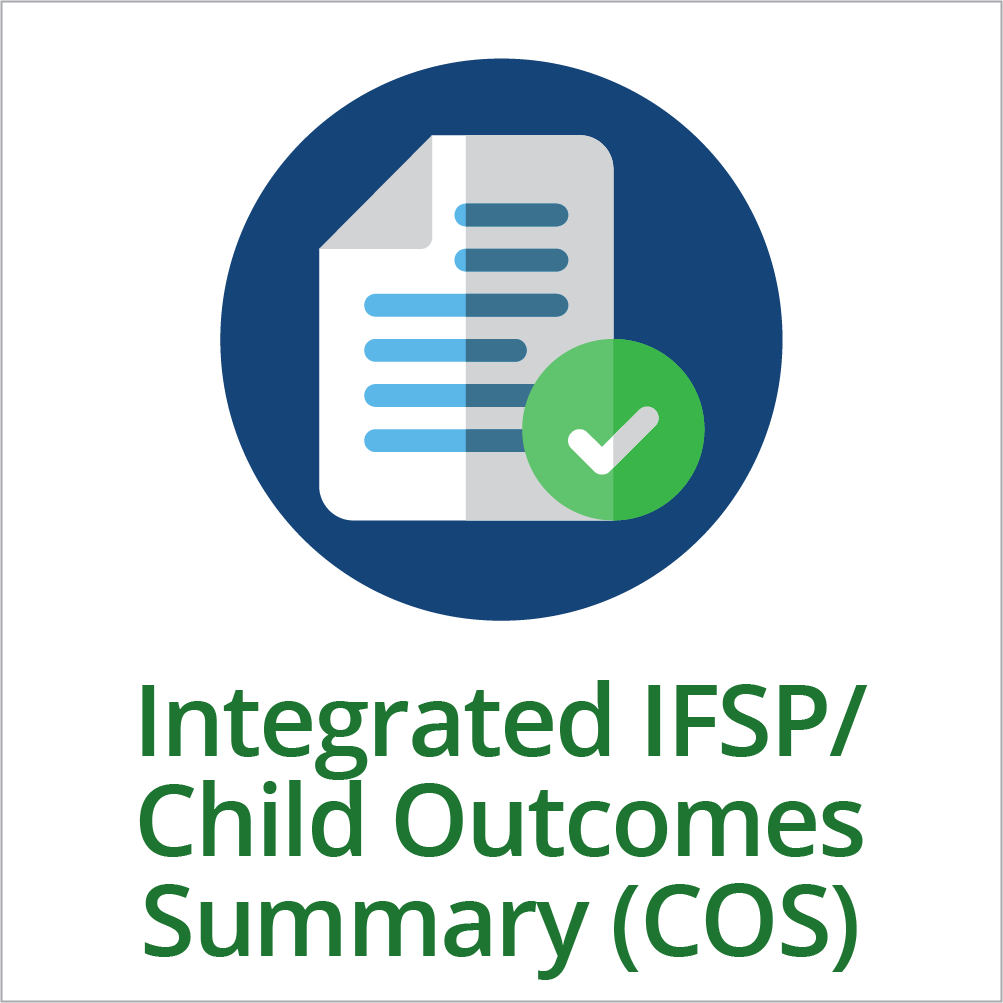
This feature refers to including child outcomes data collected via the Child Outcomes Summary (COS) process in an electronic IFSP form. The COS process is a way for states to summarize data on children for federal child outcomes reporting purposes (see detailed information at https://ectacenter.org/eco/pages/cos.asp). States that use the COS process to document children’s functioning related to the three child outcomes can include that information in the IFSP form. This can improve the quality of child outcomes data, as well as add value for IFSP team and programmatic decision-making.
Connection to DaSy Data System Framework:
- Purpose and Vision QI2: The purpose and vision include the Part C/Part B 619 state program’s intents and goals for the data system.
- Data Use QI4: Part C/Part B 619 state and local staff or their representatives disseminate data products to users to meet their needs.
Potential Data Elements
- COS ratings (entry, exit, and optional interim rating[s]) for each outcome
- Progress questions (yes/no) at exit and interim (optional) and rationale for answer
- Notes/documentation for COS ratings
Functionality
- User interface
- Summary reports
- Validation checks
- IFSP interface
Key Considerations
- The integration of child outcomes can occur throughout the IFSP process. States must choose how to implement the exact integration of the outcomes measurement in the IFSP. IFSP forms can differ in where and how they include outcomes measurement in the content and sequence of addressing IFSP content requirements.
- Begin IFSP/COS integration by identifying a sequence for gathering information about children’s functioning from families, assessments, eligibility, child outcomes measurement methods, and in the development of individualized child and family outcomes.
- Consider building validation checks into the data system to ensure that COS data entry is complete and reasonable, including checks for impossible ratings (e.g., progress question response cannot be “no” if child receives a COS rating of 3 at entry and 4 at exit), and that data entry is in accordance with state requirements.
- Determine whether a numerical COS rating or descriptor statement will be displayed in the IFSP. If displaying descriptor statements, the data system still must capture the numerical rating for purposes of backend reporting calculation.
State Examples
Maryland
Video Demonstration
- Shows how COS data (via descriptor statements) are captured in the context of completing the Strengths and Needs Summary page of the IFSP.
- Online IFSP User Manual (see page 75). This manual provides users with instructions on entering data into the Online IFSP, as well as using other system functions, such as reporting.
Kansas
- ECO Process Guidance Document. This document describes the process used to document data on the early childhood outcomes, including the use of descriptor statements (rather than numerals).
- Kansas Integrated Child Outcomes PDF. This PDF shows how information about the three child outcomes is collected on the Present Level of Development page of the IFSP.
Washington
- Early Supports for Infants and Toddlers (ESIT) Data Management System (DMS) Replacement Training guide (v1.1). This guide contains exercises to assist staff in using and entering data into the online IFSP. Refer to Chapter 5, Entry COS and Initial IFSP (page 43) and Chapter 7, Exit COS and Transition (page 64).
Related Resources
- ECTA Center Website—Outcomes Measurement: IFSP/IEP-Outcomes Integration
The website shares some of the materials that the ECTA Center has developed to support states that are making changes to their early intervention systems and integrating the IFSP and COS processes. - How to Successfully Integrate the Child Outcomes Summary (COS) Process into the IFSP Process as a SSIP Implementation Activity (Improving Data, Improving Outcomes Conference, 2016)
This session addresses the key steps in successful implementation of strategies to integrate the COS process into the IFSP process. Directors from two Part C programs share their successes and challenges, and provide recommendations to others on infrastructure and practice changes. - Integrating Child Outcomes Measurement into the IFSP: A Summary of State Approaches (ECTA/DaSy Centers, 2016)
This document includes summaries of the approaches states are using to capture child outcomes data in their IFSP forms and describes the use of child outcomes descriptor statements (rather than numerical ratings).
Published June 2017.

